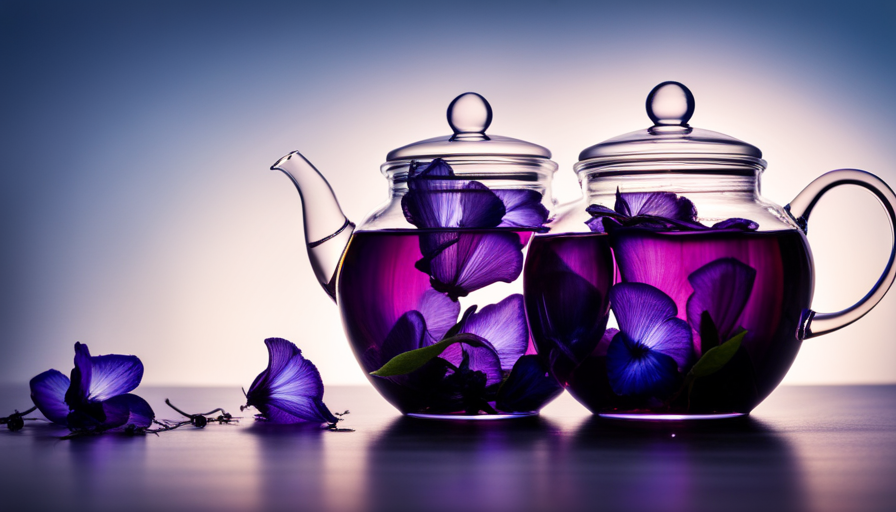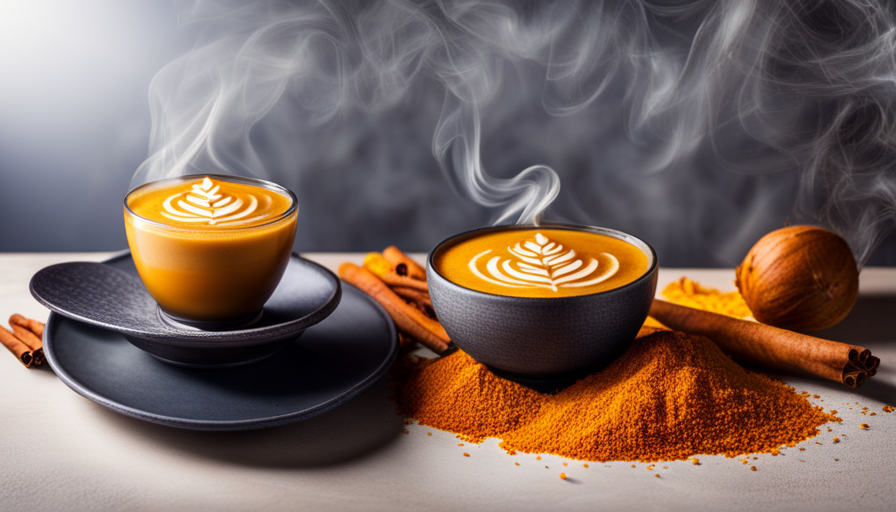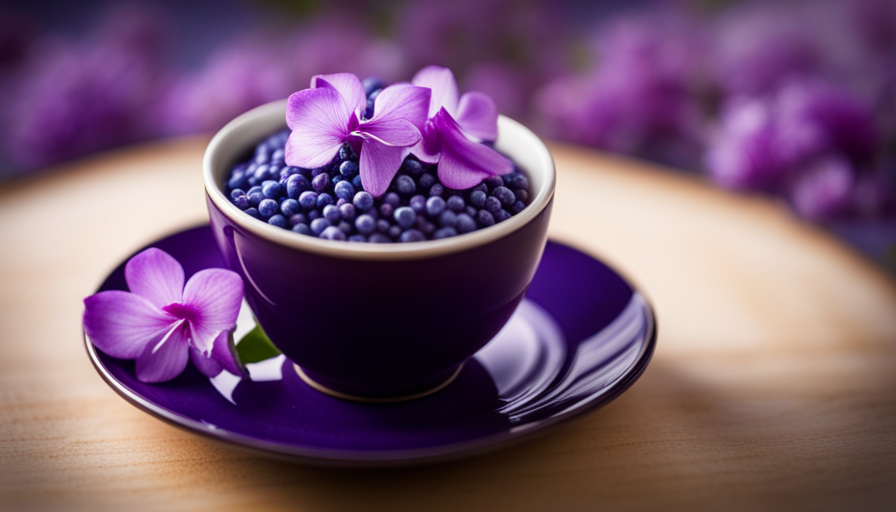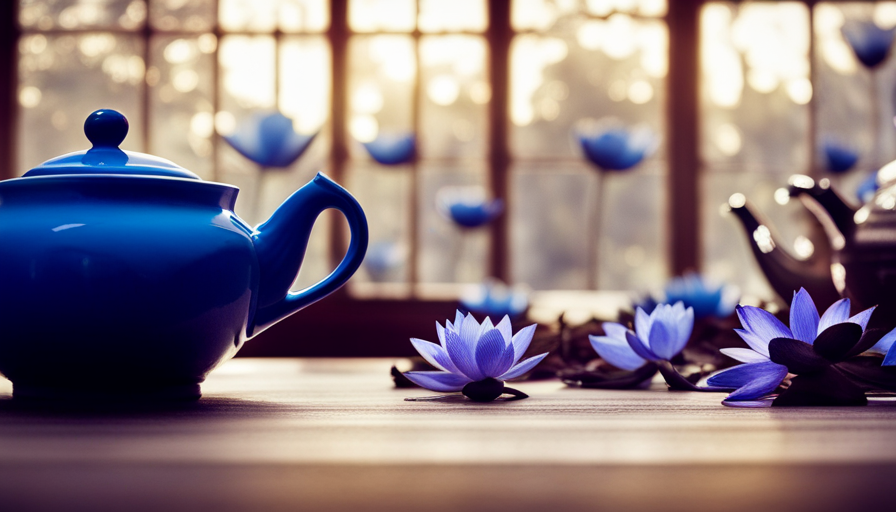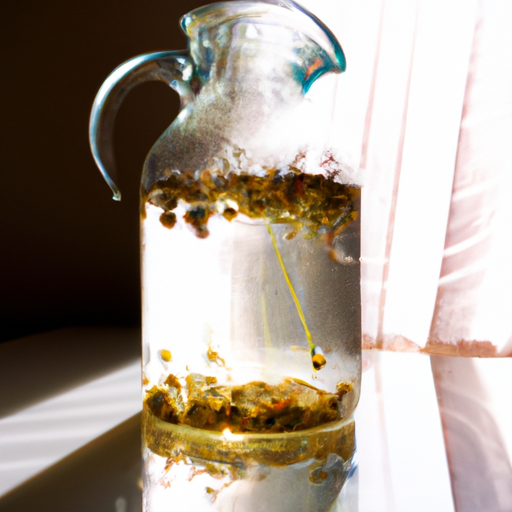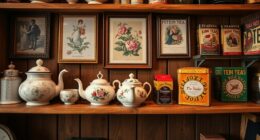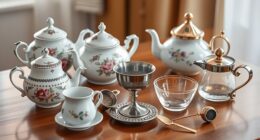Have you ever thought about how to prepare a calming and visually appealing cup of butterfly pea flower tea? Well, search no more! In this article, I will walk you through the detailed process of making this delightful drink.
Gather your ingredients and tools, including the vibrant butterfly pea flowers, boiling water, and flavor enhancers like lemon, honey, or mint.
With just a few simple steps, you can steep the flowers to extract their beautiful blue color and delicate flavor. And don’t forget to explore different variations and recipes to find your perfect cup of tea.
Not only is butterfly pea flower tea a treat for the senses, but it also offers numerous health benefits. So, join me as we embark on a journey to discover the secrets of making the perfect cup of butterfly pea flower tea!
Key Takeaways
- Butterfly pea flower tea is made using boiling water, butterfly pea flowers, and flavor enhancers like lemon, honey, or mint.
- The tea offers numerous health benefits, including antioxidants and anti-inflammatory properties.
- Different methods can be used to steep the flowers, such as adding them directly to the water or tying them in a muslin cloth or tea bag.
- Straining the tea is important to remove any leftover flowers or debris and ensure a clean drinking experience.
Introduction to Butterfly Pea Flower Tea
If you’re looking for a unique and visually stunning tea, you should definitely try butterfly pea flower tea. This tea not only offers a delightful taste but also provides numerous health benefits.
The butterfly pea flower, scientifically known as Clitoria ternatea, has been used for centuries in traditional medicine and cuisine. Originating in Southeast Asia, it has a rich history of being used for its healing properties.
Butterfly pea flower tea is known for its vibrant blue color, which comes from the natural pigments found in the flowers. When brewed, the tea turns a mesmerizing deep blue hue, making it a beautiful beverage to serve. But the benefits of butterfly pea flower tea go beyond its appearance. It is rich in antioxidants, which help in fighting free radicals and reducing oxidative stress in the body. Additionally, it is believed to have anti-inflammatory properties and can aid in digestion.
To make this tea, you’ll need a handful of dried butterfly pea flowers, hot water, and a teapot or mug. Simply steep the flowers in hot water for a few minutes, and watch as the water transforms into a stunning blue color. You can enhance the flavor by adding honey or lemon juice, depending on your preference.
So, gather the ingredients and tools needed to brew your own cup of butterfly pea flower tea and experience its unique taste and health benefits.
Gather the Ingredients and Tools
First, you’ll need to gather all the necessary ingredients and tools for this refreshing beverage. To make butterfly pea flower tea, you will need dried butterfly pea flowers, water, and a teapot or a saucepan. You can find dried butterfly pea flowers at specialty tea stores or online. Make sure to get organic and pesticide-free flowers for the best taste and quality.
For the brewing process, start by rinsing the dried butterfly pea flowers under cold water to remove any impurities. Then, place a handful of flowers into your teapot or saucepan. The general rule of thumb is to use about 2-3 flowers per cup of water. Adjust the quantity according to your preference for a stronger or milder flavor.
Next, boil water in a kettle or saucepan. Once the water reaches a rolling boil, carefully pour it over the butterfly pea flowers in the teapot or saucepan. Allow the flowers to steep for about 5-10 minutes or until the desired color is achieved. The longer the steeping time, the deeper the blue hue will be.
In the subsequent section about boiling water, we’ll explore the importance of using the right temperature for brewing butterfly pea flower tea.
Boil Water
To start the brewing process, you’ll need to boil water until it reaches a rolling boil. Boiling water is an essential step in making tea as it helps to extract the flavors and nutrients from the butterfly pea flowers.
Here’s a step-by-step guide on how to boil water for your butterfly pea flower tea:
-
Fill a kettle or pot with fresh, cold water. It’s important to use fresh water to ensure a clean and pure taste.
-
Place the kettle or pot on the stovetop and turn the heat to high. It’s recommended to use medium-high heat to bring the water to a rolling boil.
-
Keep an eye on the water as it heats up. You’ll notice tiny bubbles forming at the bottom of the pot. This is a sign that the water is gradually heating up.
-
Once the water starts to boil vigorously with large bubbles rising to the surface, it has reached a rolling boil. At this point, you can turn off the heat.
Now that the water is boiling, you’re ready to move on to the next step of steeping the butterfly pea flowers.
Steep the Butterfly Pea Flowers
Once the water’s reached a rolling boil, it’s time to infuse the enchanting hues and delicate flavors of the butterfly pea flowers into your steaming cup of bliss. Steeping butterfly pea flowers is a simple yet crucial step in making this mesmerizing tea.
There are a few different methods you can use to steep the flowers, depending on your preference and the time you have. One method is to simply add the dried butterfly pea flowers to a teapot or cup and pour the boiling water over them. Let the flowers steep for about 5 to 10 minutes, allowing their vibrant blue color and subtle earthy taste to fully develop.
Another method is to tie the flowers in a muslin cloth or tea bag and steep them in the boiling water for the same amount of time. This’ll make it easier to strain the flowers later.
Drinking butterfly pea flower tea has numerous health benefits. The tea’s rich in antioxidants, which can help protect your body against cell damage and reduce the risk of chronic diseases. It’s also known to have anti-inflammatory properties, promoting a healthy immune system. Additionally, butterfly pea flower tea’s believed to support brain health and improve cognitive function.
As the flowers steep in the hot water, their vibrant blue color’ll slowly infuse into the liquid, creating a mesmerizing visual experience. Once the steeping time’s up, it’s time to move on to the next step of adding flavor enhancements such as lemon, honey, or mint, which’ll complement the delicate taste of the butterfly pea flower tea without overpowering it.
Add Flavor Enhancements (e.g., lemon, honey, mint)
Enhance your mesmerizing cup of butterfly pea flower tea with the vibrant zest of lemon, the sweet touch of honey, or the refreshing burst of mint. These flavorful additions not only elevate the taste of your tea but also provide additional health benefits.
Lemon is a popular choice for enhancing butterfly pea flower tea as it adds a tangy and citrusy flavor. It complements the earthy and floral notes of the tea, creating a refreshing and invigorating drink. Lemon is also rich in vitamin C and antioxidants, which can boost your immune system and promote overall wellness.
Honey, on the other hand, brings a natural sweetness to the tea, balancing out its subtle bitterness. It adds depth and complexity to the flavor profile and provides a soothing effect. Additionally, honey has antibacterial properties and can help soothe a sore throat or cough.
If you prefer a more refreshing twist to your butterfly pea flower tea, try adding some fresh mint leaves. Mint adds a cool and invigorating flavor that pairs well with the floral notes of the tea. It can also aid in digestion and provide a natural burst of energy.
Incorporating these flavor enhancements not only adds a delicious twist to your butterfly pea flower tea but also offers various health benefits. Now, let’s move on to the next step, which is to strain the tea.
Strain the Tea
Get ready to strain your mesmerizing cup of butterfly pea flower tea and enjoy the smooth and pure essence of this vibrant infusion. Straining the tea is an essential step to remove any leftover flowers or debris, ensuring a clean and delightful drinking experience.
There are different straining techniques you can use, depending on your preference and the tools you have at your disposal. One option is to use a fine-mesh strainer, which effectively catches any solids while allowing the liquid to pass through. This method is quick and easy, perfect for those who want a hassle-free process.
Another technique is to use a cheesecloth or muslin cloth to strain the tea. This method provides a finer strain, resulting in a smoother texture. It may take a bit more time and effort, but the result is well worth it.
Once you have strained your butterfly pea flower tea, you can also explore using the flowers in other recipes. They can be added to baked goods, such as cakes or muffins, to infuse a unique flavor and stunning blue color. The flowers can also be used to make syrups or infused in cocktails for a touch of elegance.
Now that your tea is strained and ready to serve, you can move on to the next step of enjoying this enchanting beverage.
Serve and Enjoy
To fully savor the captivating essence of this vibrant infusion, it’s time to sit back, sip away, and let the soothing blue elixir transport you to a tranquil oasis. Now that your butterfly pea flower tea is perfectly brewed and strained, it’s time to serve and enjoy this delightful beverage.
To enhance the visual appeal and flavor of your tea, there are several ways to garnish it. You can add a squeeze of lemon or lime to create a refreshing citrus twist. Mint leaves can also be added for a hint of freshness. For those with a sweet tooth, a drizzle of honey or a sprinkle of sugar can add a touch of sweetness to the tea.
The best time to enjoy butterfly pea flower tea is during a quiet moment of relaxation. Whether it’s in the morning to start your day on a calming note or in the evening to unwind after a long day, this tea is perfect for any occasion.
To explore different variations and recipes using butterfly pea flower tea, head to the next section. Let’s delve into the exciting world of creative concoctions and discover new ways to enjoy this enchanting brew.
Explore Different Variations and Recipes
Now that you’ve learned how to serve and enjoy a delicious cup of butterfly pea flower tea, let’s explore different variations and recipes to further indulge in this delightful beverage.
One of the most popular ways to elevate your tea experience is by incorporating butterfly pea flower into cocktails. The vibrant blue hue of the tea makes for a stunning addition to any mixed drink. Try adding a splash of butterfly pea flower tea to your favorite gin and tonic or experiment with creating your own unique cocktail recipes.
If you’re in the mood for something warm and comforting, why not try a butterfly pea flower tea latte? This velvety and creamy drink combines the earthy flavors of the tea with frothy milk and a touch of sweetness. Simply brew a strong cup of butterfly pea flower tea and mix it with steamed milk and a sweetener of your choice. For an extra indulgence, top it off with a sprinkle of cinnamon or nutmeg.
Now that you’ve explored these different variations and recipes, it’s time to delve into the health benefits of butterfly pea flower tea. Discover how this magical flower can improve your well-being and boost your overall health.
Learn About the Health Benefits of Butterfly Pea Flower Tea
Discover how indulging in a cup of this enchanting beverage can enhance your well-being and boost your overall health. Butterfly pea flower tea offers a myriad of health benefits that make it a great addition to your daily routine.
Packed with antioxidants, this tea helps protect your body against free radicals and reduces the risk of chronic diseases. Additionally, it’s known to support brain health and improve cognitive function due to its natural nootropic properties.
Drinking butterfly pea flower tea can also aid in digestion and promote a healthy gut. It’s been used for centuries in traditional medicine to alleviate stomach issues such as bloating and indigestion. Furthermore, this vibrant blue tea is believed to have anti-inflammatory properties that can help reduce inflammation in the body.
To prepare butterfly pea flower tea, simply steep a handful of dried flowers in hot water for 5-10 minutes. You can also add lemon juice or honey to enhance the flavor and enjoy it hot or iced.
Now, let’s move on to the next section where I’ll share some tips and tricks for making the perfect cup of butterfly pea flower tea.
Tips and Tricks for Making the Perfect Cup of Butterfly Pea Flower Tea
Enhance your tea-drinking experience with these expert tips and tricks to create the perfect cup of this enchanting blue elixir.
-
Brewing Techniques: To bring out the full flavor and vibrant color of butterfly pea flower tea, it’s important to use the right brewing technique. Start by boiling water and pour it over the dried butterfly pea flowers. Let it steep for about 5 minutes, or until the water turns a beautiful blue hue. Strain the flowers and your tea’s ready to be enjoyed.
-
Creative Serving Ideas: Butterfly pea flower tea can be served in a variety of creative ways to impress your guests or simply elevate your tea-drinking experience. Here are a few ideas to try:
- Add a squeeze of lemon or lime to your tea to watch the color change from blue to purple.
- Mix the tea with citrus fruits or pineapple juice for a refreshing and tropical twist.
- Create stunning layered drinks by pouring the tea over ice and adding different colored fruit juices or syrups.
By following these brewing techniques and exploring creative serving ideas, you can make the perfect cup of butterfly pea flower tea that not only tastes delicious but also looks visually appealing. So go ahead, experiment and enjoy this magical tea experience.
Frequently Asked Questions
Can butterfly pea flower tea be made with dried flowers?
Sure, you can definitely make butterfly pea flower tea with dried flowers. Using dried flowers has its own set of benefits, such as a longer shelf life and the ability to easily store them.
When it comes to alternative tea options, using dried flowers opens up a world of possibilities. You can experiment with different combinations and flavors to create unique blends.
So go ahead, grab those dried flowers and let your creativity flow!
How long does it take to steep butterfly pea flowers?
The steeping time for butterfly pea flowers varies depending on personal preference and desired intensity of flavor. Generally, I recommend steeping the flowers in hot water for about 5-10 minutes. You can experiment with different brewing techniques, such as adjusting the water temperature or using a longer steeping time, to achieve the desired color and taste.
Remember to strain the flowers before enjoying your vibrant and refreshing butterfly pea flower tea.
What are some common flavor enhancements used in butterfly pea flower tea?
Looking to enhance the flavor of your butterfly pea flower tea? There are endless possibilities when it comes to flavor combinations!
One common enhancement is adding a squeeze of lemon or lime juice, which not only adds a refreshing tang but also transforms the tea’s color from blue to purple.
Another option is to sweeten the tea with honey or agave syrup for a touch of natural sweetness. These flavor enhancements not only elevate the taste but also offer additional health benefits.
Can I reuse the butterfly pea flowers for a second steeping?
Yes, you can definitely reuse the butterfly pea flowers for a second steeping. After making the initial tea, you can save the used flowers and keep them for alternative uses.
One option is to use them to make a natural dye for fabrics or food coloring. Simply boil the flowers again in water, strain the liquid, and use it for dyeing or coloring. This way, you can get more out of your butterfly pea flowers and explore different creative possibilities.
Are there any potential side effects or allergies associated with drinking butterfly pea flower tea?
There are no known side effects or allergies associated with drinking butterfly pea flower tea. In fact, it’s believed to have potential health benefits, such as improving digestion, boosting brain function, and promoting healthy hair and skin. However, there’s no recommended daily intake for butterfly pea flower tea. As always, individuals should listen to their bodies and consume it in moderation.
Conclusion
In conclusion, making butterfly pea flower tea is a delightful and simple process that allows you to experience the beauty and health benefits of this unique beverage. By following the steps outlined in this article, you can create a cup of tea that’s both visually stunning and deliciously refreshing.
So why not give it a try and let your taste buds take flight with this exquisite tea? Remember, the world’s your oyster, and butterfly pea flower tea is like a ray of sunshine on a cloudy day, brightening up your senses and leaving you feeling rejuvenated.
Cheers to the wonders of nature and the joy of a perfect cup of tea!

